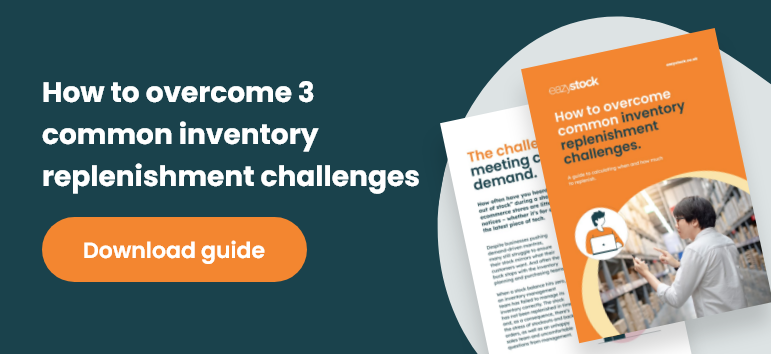How to achieve effective stock replenishment
Stock replenishment is an important aspect of inventory management, as it ensures the right stock items are being reordered to meet customer demand. Stock (or inventory) replenishment is the process of moving items along the supply chain so they are ready to be picked and shipped, thus fulfilling orders on time.
Effective stock replenishment
Any supply chain management professional will tell you that it’s an arduous balancing act to maintain optimized inventory levels through effective stock replenishment.
Yet inventory replenishment planning – done correctly – can have a really positive impact on your business in terms of improving operational efficiency, reducing supply chain risk and enhancing bottom line profitability.
Here’s quick overview of what stock replenishment is and how great stock replenishment methods can truly add value to any business.
How does the stock replenishment process work?
As goods leave a warehouse, or are used in a manufacturing process, stock replenishment teams will ensure they have the back-up to refill the shelves with inventory items, ready for the next round of picking.
This means that in the background, an inventory management team needs to be monitoring stock levels and focusing on ordering the right inventory items, at the right time to ensure stock availability, ready for replenishment.
Why are effective stock replenishment methods important?
Effective stock replenishment methods ensure the efficient flow of inventory items as they move through a supply chain. Ultimately high levels of stock availability, due to effective replenishment processes, deliver high service levels that in turn ensure customer satisfaction.
What’s the financial impact of effective stock replenishment?
Stock replenishment can have a significant effect on a business’s inventory risk and consequential financial situation.
In reality most businesses don’t have the working capital to stock every SKU to the levels required for 100% availability. Instead they balance the costs of holding stock e.g. warehouse costs, opportunity costs and cashflow problems, with the risk of not having enough e.g. missed sales targets or costly backorders.
A smart replenishment planning team will be able to balance this inventory investment risk by:
- Accurately forecasting future stock requirements – using statistical demand forecasting techniques
- Prioritizing which stock items to carry based on their forecasts, an item’s demand volatility and pick frequency and cost of sales.
They can then set service level targets (or order fulfillment targets) based on these factors e.g. set higher service level targets for items that are cheaper to sell and have consistently high demand, compared to those that are expensive and have low, intermittent demand.
With stellar stock replenishment methods, businesses are in a much stronger financial position. That is, they’ll be able to invest the right amount of working capital in stock to fill orders and optimize sales without risking a build-up of excess or even obsolete stock due to over-ordering.
Stock replenishment methods along the supply chain
Great stock replenishment can add value along the entire supply chain:
Manufacturers – ensures a continuous supply of raw materials and prevents costly delays in production.
Wholesalers – allows them to fulfill customer orders on time, keeping them loyal and coming back for more.
Retailers – helps prevent dreaded ‘out-of-stock’ scenarios and keeps customer reviews positive which is terrific for any brand.

Cost-effective stock replenishment
A key responsibility of every stock replenishment team is to negotiate the best price for the items they reorder, so that the sell-on price can be as profitable as possible.
But when looking at the bigger picture the ‘best-price’ is not always the most cost-effective way to procure a product. A smart stock replenishment strategist will understand supply and demand nuances around the items being ordered and consider factors such as:
Lead times – how quickly is the order needed? Is it worth paying more for a faster shipment to fulfill important customer orders?
Quantity – is the discount achieved by bulk-buying outweighed by higher carrying costs and tying up additional capital?
Min/max quantities – based on forecasts, which items are the best to add to an order to reach a supplier’s min order quantity?
Analyzing stock levels, forecasts and supplier constraints provides a deeper level of insight that makes it easier to replenish inventory at the right price. With supply chain procurement increasingly scrutinized by management teams, any stock replenishment savings (that don’t impact service levels) will be seen as extremely favorable.
An efficient stock replenishment process
An efficient stock replenishment process involves:
- accurate demand forecasting
- optimizing inventory levels
- purchasing at the right time and in the right quantities
- tracking and reporting KPIs for inventory analysis and continuous improvement
Managing each of these factors in an enterprise resource planning (ERP) or warehouse management system (WMS) can be challenging. Inventory planners often resort to spreadsheets to do their forecasting and calculate replenishment parameters including safety stock, reorder points and reorder quantities.
Businesses are therefore starting to invest in stock replenishment systems and software that makes replenishment activities more efficient in the following ways:
Manual stock replenishment |
Automated stock replenishment |
| Updating spreadsheets is time-consuming | Spreadsheets are no longer needed |
| Data is quickly out of date, as demand and supply variables change so quickly | Purchasing suggestions are updated daily based on updated forecasts and stock levels |
| Spreadsheets are prone to human error | Software functionality includes alerts for abnormal activity e.g. demand outliers, reports showing risk of stock-outs, etc |
| Inaccuracies lead to things going wrong e.g. stressful stock-outs and back orders | Teams have more control over replenishment planning, eliminating the element of ‘fire-fighting’ |
| Order cycle times (time between each order) are slower e.g. order when you can, not when you should | Order cycle times can be set up as required and reorder points automatically update accordingly |
| Constant number crunching means a lack of time for strategy | Less time spent on forecasting, planning and reordering makes more time for strategic thinking |
Help your business benefit from a smart stock replenishment strategy
Stock replenishment has the potential to affect every aspect of a business – from manufacturing to marketing. It’s therefore crucial to continuously look at ways to enhance your replenishment planning processes.
If you’re looking to improve your stock replenishment processes or want to investigate how inventory replenishment software could help your business, contact the EazyStock team for more details.










